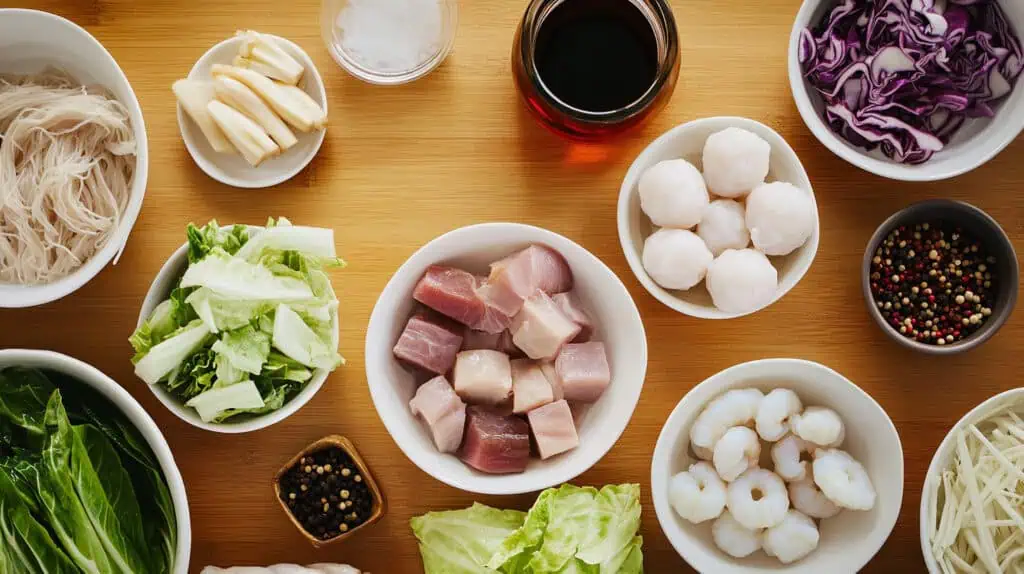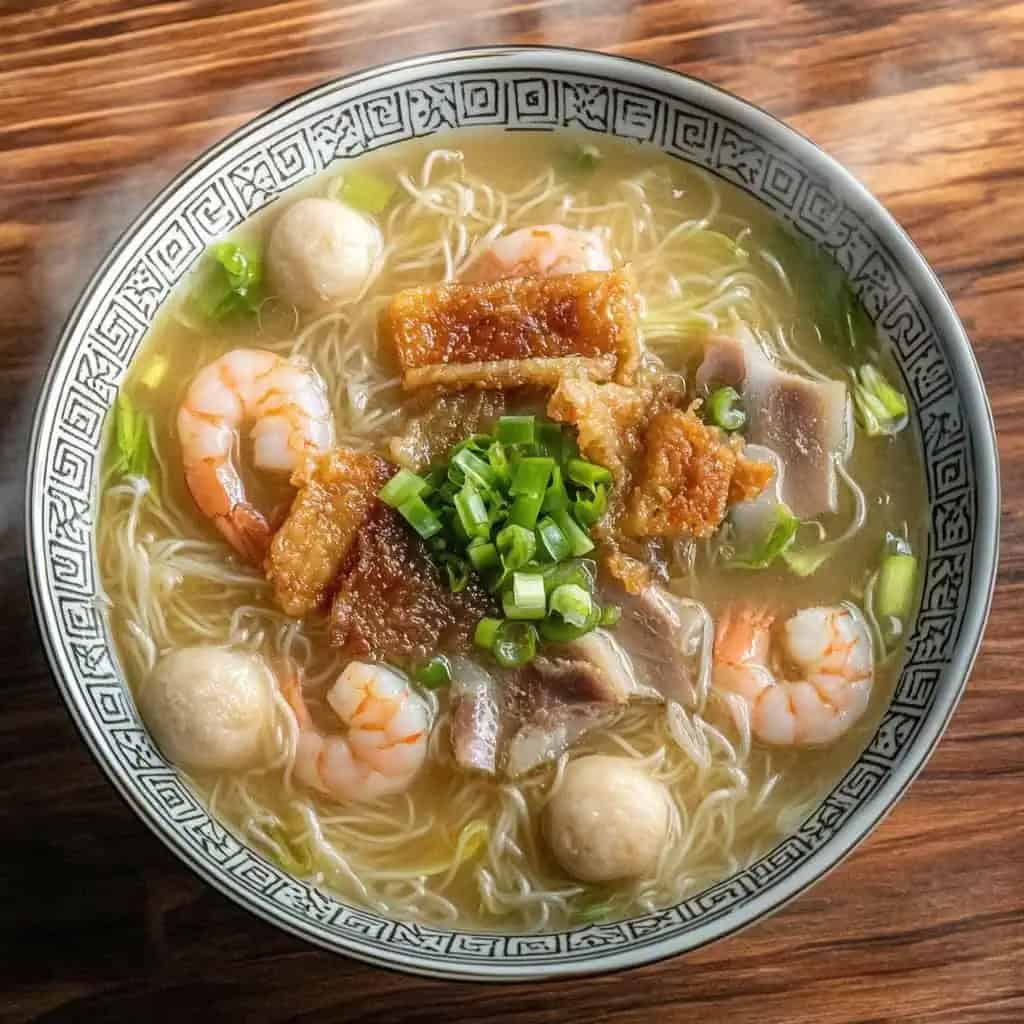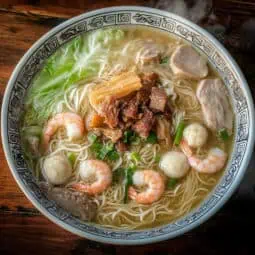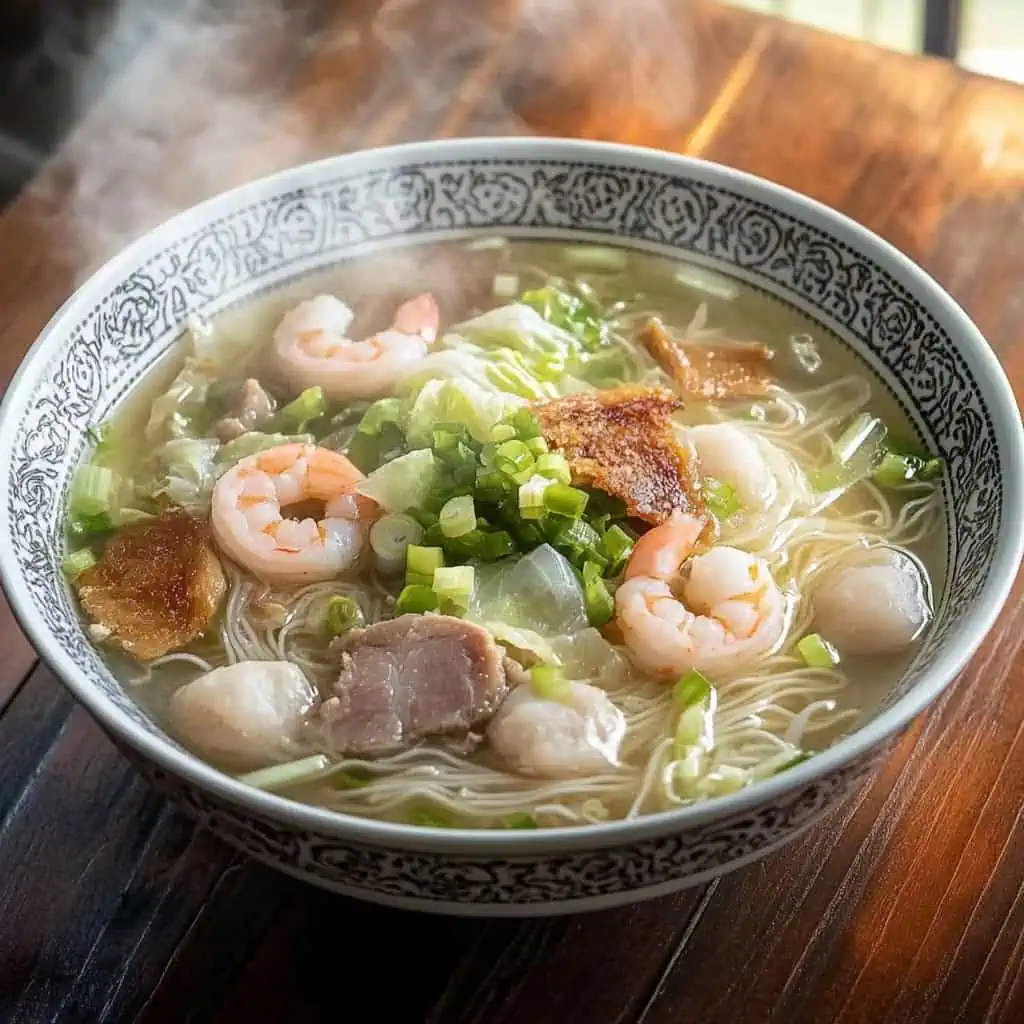You know what's funny? I used to always skip misua at family gatherings. Something about those super thin noodles just didn't appeal to me - they seemed too simple, maybe even a bit boring. But then my Lola made this version one New Year's Day, throwing in leftover holiday lechon, some fresh shrimp, and these perfectly crispy pieces of liempo. Let me tell you, it completely changed my mind.
Now I get why this noodle soup is such a comfort food staple in Filipino homes. It's not just about the noodles, it's about how they soak up that rich chicken broth, how they complement the mix of textures from the crispy pork to the tender shrimp, and how everything comes together in less time than it takes to watch a sitcom episode. This misua recipe might just change your mind about these thin wheat noodles ,too.
Jump to:

Why You'll Love This Recipe
- Quick and comforting: Ready in just 35 minutes
- Versatile: Works perfectly with leftover holiday meats
- Budget-friendly: Uses simple, accessible ingredients
- Cultural significance: Traditionally served during New Year for long life
- One-pot meal: Easy cleanup and preparation
Ingredients
This misua soup combines ingredients that create perfect balance and depth. The thin wheat noodles absorb the rich chicken broth while providing a satisfying texture. Crispy pork belly adds savory fat and protein, complemented by tender shrimp for sweetness and squid balls for a bouncy contrast.
Fresh cabbage and patola bring necessary lightness and nutrition. The aromatics—garlic and red onion—create a flavorful foundation, while fish sauce adds that essential umami depth Filipinos love.
Everything cooks at different times, allowing each ingredient to maintain its ideal texture while contributing to a harmonious, comforting soup that's both economical and deeply satisfying.

- 60 g misua noodles (3 bunches)
- ½ cup pork belly, cubed
- ½ cup shrimps
- 6 pcs squid balls, quartered
- 1 cup cabbage, chopped
- 4 cloves garlic, minced
- 1 large red onion, minced
- 1 liter chicken broth
- 1 pc patola, sliced (optional)
- Fish sauce (patis) to taste
- Freshly ground black pepper
- Cooking oil
Equipment
- Large pot or kawali: For preparing the entire soup, providing enough space for all ingredients to simmer together while allowing easy stirring
- Sharp knife and cutting board: Essential for precise cutting of pork belly, vegetables, and seafood
- Measuring cups and spoons: For accurate ingredient measurements to ensure balanced flavors
- Wooden spoon or heat-resistant spatula: For sautéing ingredients and stirring the soup without scratching your pot
- Strainer: To briefly rinse the misua noodles before adding them to the soup
- Ladle: For serving the hot soup without spills

How To Make
- Heat your cooking oil in a large pot over medium heat. Once hot, add the minced garlic and cook until it turns light golden, about 2-3 minutes. Add the minced red onions and cook until they become clear and soft.
- Now add the cubed pork belly to the pot. Cook and stir until the pork becomes brown and crispy on all sides, which takes about 5-7 minutes. Add the quartered squid balls and cook them for another 2-3 minutes.
- Pour in the chicken broth and add the sliced patola if you're using it. Let everything come to a boil, then lower the heat and let it simmer gently for 4 minutes.
- Add your misua noodles, shrimp, and chopped cabbage to the pot. Let everything simmer together for just 2 minutes - be careful not to cook longer as the noodles can become too soft.
- Finally, season your soup with fish sauce and freshly ground black pepper. Start with a small amount, taste, and add more if needed until you're happy with the flavor.
- Serve your misua soup right away while it's hot. If you like, you can add some chopped green onions on top and serve with calamansi halves on the side for squeezing over the soup.
Remember: Misua noodles cook very quickly - they only need about 2 minutes. If you cook them too long, they'll become mushy, so keep an eye on the time and serve as soon as they're done.

Tips from Lola's Kitchen
- Mind your noodles: Never overcook misua as it becomes mushy within minutes. Add them as the last ingredient and time exactly 2 minutes before serving.
- Rinse before using: Give misua noodles a quick rinse under cold water before adding to the soup - this removes excess starch and salt while preventing clumping.
- Layer your flavors: Always start by properly sautéing garlic until golden brown (not burnt) to create a rich flavor foundation for your soup.
- Crisp matters: Take your time to properly crisp the pork belly - those crispy bits provide essential texture contrast to the soft noodles.
- Homemade broth magic: Whenever possible, use homemade chicken stock instead of bouillon cubes for cleaner, more authentic flavor.
- Proper seasoning technique: Add fish sauce gradually, tasting between additions - it's much easier to add more than to fix an overly salty soup.
Substitutions
- Protein options: Replace pork belly with chicken thigh, beef strips, or tofu cubes for different dietary preferences
- Seafood alternatives: Swap shrimp for fishballs, meatballs, or crab sticks
- Vegetable choices: Substitute patola with sayote (chayote) or upo (bottle gourd) based on availability
- Broth base: Use vegetable broth instead of chicken broth for a vegetarian version
- Allium alternatives: If fresh garlic isn't available, substitute with 1 teaspoon garlic powder
- Greens variation: Replace cabbage with bok choy, spinach, or kangkong for different nutritional profiles
Troubleshooting
- Soup too salty? Add more unseasoned broth or a splash of water to dilute, and add a small chunk of peeled potato to absorb excess salt
- Noodles turned to mush? Unfortunately, mushy misua can't be fixed. For your next batch, remember to add noodles last and cook for exactly 2 minutes
- Soup too thick? Add hot broth or water gradually while stirring until desired consistency is reached
- Soup too thin? Add a small handful of additional misua noodles and simmer for 2 minutes to thicken
- Lack of flavor? Try adding a splash more fish sauce, a sprinkle of white pepper, or a spoonful of fried garlic oil to enhance depth
- Pork not crispy enough? Before adding to the soup, try cooking the pork belly separately until crispy, then add it to individual serving bowls at the last minute
Storage & Reheating
- Refrigeration: Store leftover soup in an airtight container in the refrigerator for up to 2 days maximum
- Separation note: The noodles will continue absorbing liquid while stored, so you'll notice the soup thickens significantly
- Best reheating method: Reheat on stovetop over medium-low heat, stirring occasionally to prevent sticking
- Texture restoration: Add ¼ to ½ cup fresh chicken broth per serving when reheating to rejuvenate the soup's consistency
- Component storage: For best results, store broth and solid ingredients separately from noodles if possible
- Not recommended for freezing: Misua noodles become unpleasantly mushy when frozen and thawed

FAQ
Can I make misua soup in advance for a party?
Misua is best prepared fresh, but you can prepare the broth with meat and vegetables up to 3 hours ahead, then add noodles just 2 minutes before serving.
Is misua gluten-free?
No, traditional misua noodles are made from wheat flour and contain gluten. There is currently no widely available gluten-free substitute that provides the same texture.
Can I use other types of noodles if I can't find misua?
While not traditional, you can substitute with thin rice vermicelli or angel hair pasta, though cooking times and texture will differ.
How do I keep the noodles from clumping together?
Rinse misua briefly before adding to the soup, add them while stirring the broth, and serve immediately after the 2-minute cooking time.
What's the difference between misua and sotanghon?
Misua noodles are made from wheat flour, while sotanghon (glass noodles) are made from mung bean starch. Misua cooks much faster and has a softer texture.
Can I make a spicy version of misua soup?
Absolutely! Add sliced bird's eye chilies (siling labuyo) or a teaspoon of chili garlic oil to the soup for a spicy kick.
Why is my soup turning cloudy?
This is normal and happens when starch from the misua noodles releases into the broth. For a clearer soup, rinse the noodles thoroughly before adding them.
Related
Looking for other recipes like this? Try these:

Filipino Misua Soup (Miswa)
Equipment
- Large pot or kawali (for soup preparation)
- Sharp knife and cutting board (for ingredient preparation)
- Measuring cups and spoons (for accurate portions)
- Wooden spoon or spatula (for sautéing)
- Strainer (for washing misua noodles)
- Ladle (for serving)
Ingredients
- 60 g misua noodles 3 bunches - maninipis na noodles
- ½ cup pork belly cubed (liempo, hiniwa ng parisukat)
- ½ cup shrimps hipon
- 6 pcs squid balls quartered
- 1 cup cabbage chopped (repolyo)
- 4 cloves garlic minced (bawang, dinurog)
- 1 large red onion minced (sibuyas, dinurog)
- 1 liter chicken broth sabaw ng manok
- 1 pc patola sliced (optional)
- Fish sauce patis to taste
- Freshly ground black pepper paminta
- Cooking oil mantika
Instructions
- First, heat your cooking oil in a large pot over medium heat. Once hot, add the minced garlic and cook until it turns light golden, about 2-3 minutes. Add the minced red onions and cook until they become clear and soft.
- Now add the cubed pork belly to the pot. Cook and stir until the pork becomes brown and crispy on all sides, which takes about 5-7 minutes. Add the quartered squid balls and cook them for another 2-3 minutes.
- Pour in the chicken broth and add the sliced patola if you're using it. Let everything come to a boil, then lower the heat and let it simmer gently for 4 minutes.
- Add your misua noodles, shrimp, and chopped cabbage to the pot. Let everything simmer together for just 2 minutes - be careful not to cook longer as the noodles can become too soft.
- Finally, season your soup with fish sauce and freshly ground black pepper. Start with a small amount, taste, and add more if needed until you're happy with the flavor.
- Serve your misua soup right away while it's hot. If you like, you can add some chopped green onions on top and serve with calamansi halves on the side for squeezing over the soup.
- Remember: Misua noodles cook very quickly - they only need about 2 minutes. If you cook them too long, they'll become mushy, so keep an eye on the time and serve as soon as they're done.
Tips from Lola's Kitchen
- Never overcook misua as it becomes mushy quickly
- Add noodles last to prevent them from becoming too soft
- Rinse misua noodles briefly before cooking to remove excess salt
- For better flavor, use homemade chicken stock
- Toast garlic until golden for better aroma
Nutrition
The Story Behind Filipino Misua Soup
Growing up in a Filipino household, misua always made its grand appearance during two occasions - when someone was feeling under the weather, and without fail, during New Year celebrations. This humble noodle soup, with its characteristic thin wheat vermicelli, actually traces its roots back to Fujian, China, where it's known as "mee sua" or "mian xian" - a type of noodle traditionally served during birthdays and celebrations.
Like many beloved Filipino dishes, misua showcases our culture's remarkable ability to adopt and transform Chinese culinary traditions into something uniquely our own. When Chinese merchants settled in the Philippines centuries ago, they brought with them these delicate wheat noodles. Over time, Filipino home cooks embraced misua, incorporating local ingredients and adapting it to suit Filipino tastes. What was once a simple Chinese noodle soup evolved into a comforting bowl filled with crispy pork belly, fresh seafood, and local vegetables like patola.
The symbolism of misua in Filipino culture runs deep. The extraordinary length of these thin noodles represents longevity and good fortune, which explains why serving misua during New Year has become a cherished tradition in countless Filipino homes. It's believed that eating these long noodles as the calendar turns ensures a long and prosperous life ahead - a belief shared across many Southeast Asian cultures influenced by Chinese traditions.
But perhaps what makes Filipino misua truly special is its transformation into a practical yet meaningful dish. In the days following Noche Buena and Media Noche, when refrigerators are stuffed with holiday leftovers, Filipino home cooks cleverly incorporate remaining lechon, ham, or chicken into their misua. This resourceful approach not only prevents food waste but also adds layers of flavor to the soup that you simply can't achieve with fresh ingredients alone.
Today, misua continues to evolve while maintaining its significance in Filipino cuisine. From the humble pantries of our grandmothers to modern Filipino kitchens worldwide, this noodle soup represents more than just sustenance - it's a testament to our culture's ability to honor traditions while embracing practical innovation. Whether served during celebrations, sick days, or simply when comfort food cravings strike, misua remains a beloved fixture in Filipino home cooking, bridging generations through the universal language of nourishing soup.










Comments
No Comments